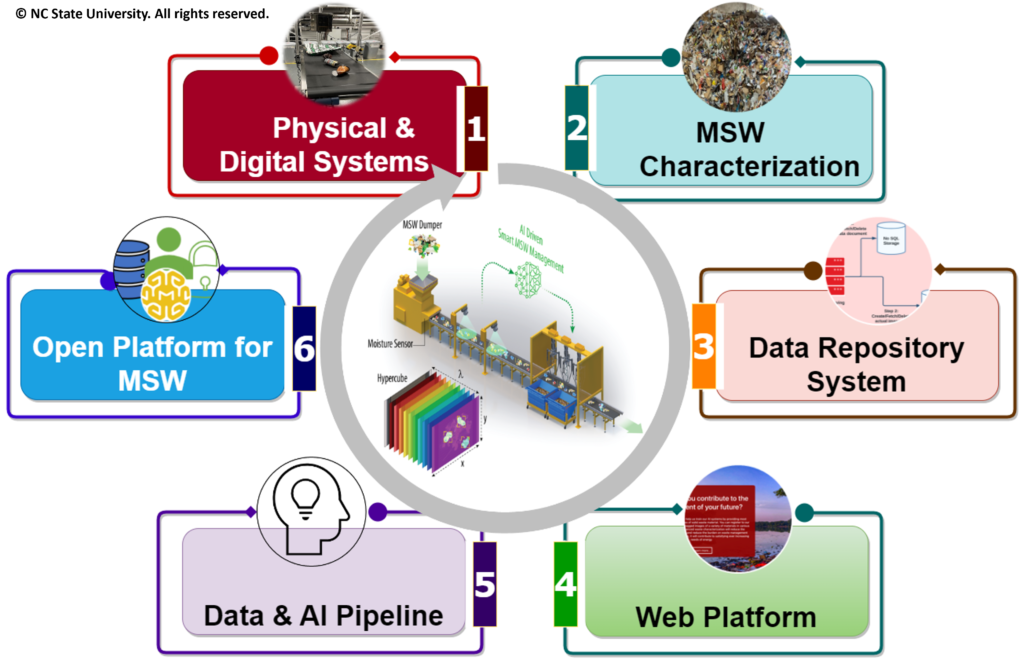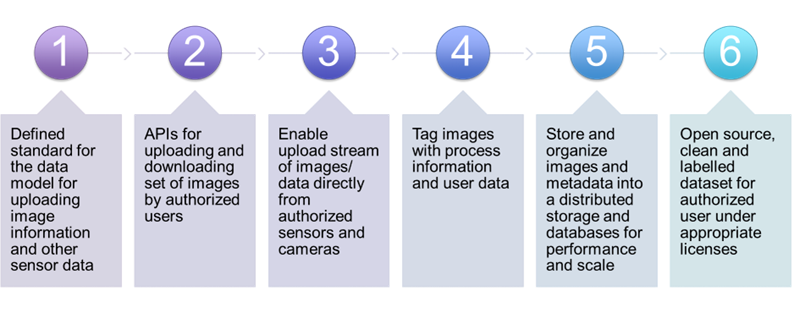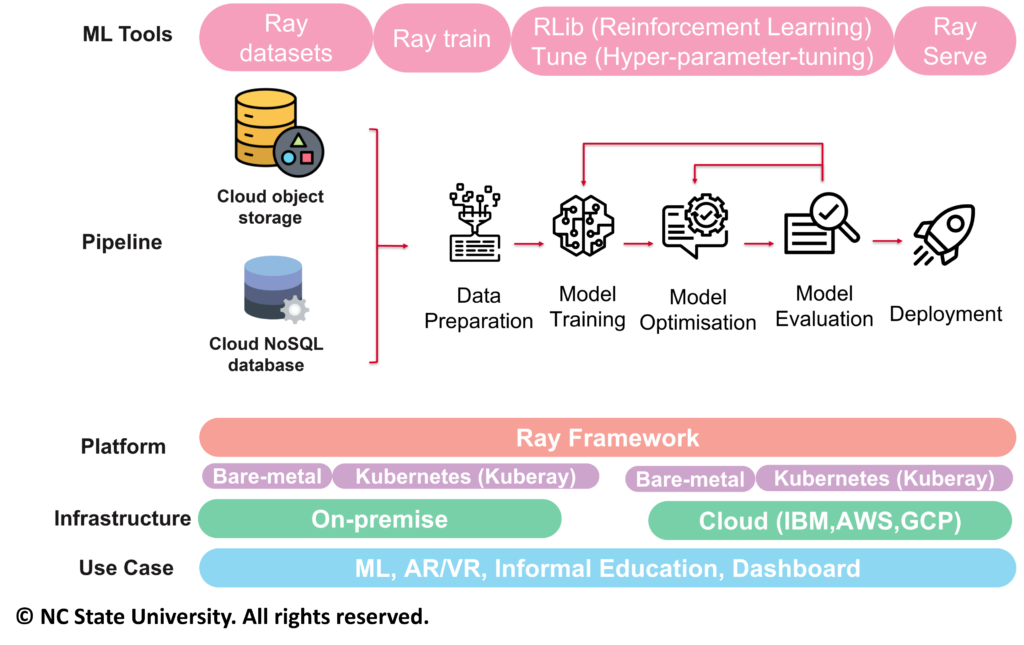Research
We focus on pioneering advanced technologies and methodologies that transform waste into valuable renewable carbon resources, suitable for diverse industries.
Our dedication to sustainability and innovation compels us to continuously push the boundaries of waste transformation. Through these efforts, we actively contribute to 4 pillars of sustainability (human, social, economic and environmental), fostering a sustainable future built on innovation and responsible resource utilization.
AI-Enabled Hyperspectral Imaging Augmented with Multi-Sensory Information for Rapid/Real-time Analysis of Non-Recycled MSW for Conversion to Energy

Our research is focused on developing an “AI-Driven Smart MSW Management System” using computer vision and artificial intelligence (AI) to identify and characterize various organic fractions of MSW. The system aims to enable the production of conversion-ready feedstock for energy generation.
The research is divided into five major areas:

1. Physical and digital system setup and integration for non-recycled MSW characterization:
Our system is designed to integrate various advanced technologies, including visual and spectral cameras, IoT, and sensors, to achieve rapid identification and characterization of different fractions of MSW.

Our key technology includes hyperspectral imaging to capture detailed spectral data allowing for the identification of waste based on its chemical properties. By combining this technology with IoT and sensors, we collect data in real-time to rapidly characterize and separate MSW fractions for conversion ready-feedstock development.
2. MSW Characterization:
MSW characterization is essential for effective waste management and conversion ready-feedstock development. We collect MSW samples from residential, commercial, and institutional sources to
- Characterize, separate and concentrate in various fractions of MSW
- Capture visual and hyperspectral images from controlled and actual MSW
- Collect and push labeled data sets to the data repository system
ASTM D-5231 standard is followed for the manual sorting of MSW samples to ensure that our data is comparable to that collected by municipalities and private organizations. We also develop protocols for identifying hazardous materials such as PFAS, biological hazards, and other highly contaminated materials while determining safe handling and disposal methods.


Non-recycled MSW contains significant organic content available for upcycling to high value biofuels, biopower, biochemicals, and bioproducts. By collecting visual images, hyperspectral images, metadata and evaluating physical, chemical and compositional attributes such as moisture, density, pH, particle size and distribution, surface area, composition (cellulose, lignin, extractives), crystallinity, energy density/calorific value, and elemental analyses, we are creating unique datasets for machine learning model building to identify and separate materials that have the potential to be recovered as renewable carbon resources and make decisions for upcycling to high value biofuels, biopower, biochemicals, and/or bioproducts.
Building these unique datasets from real MSW and clean and simulated-contaminated MSW samples is essential for effective waste management, reducing the environmental impact of waste disposal and promoting a circular economy. We have developed a patented process to procure, handle, characterize, concentrate, pretreat and homogenize the non-recyclable MSW to not only make the waste characterization more accurate and reliable but also make it conversion ready for biofuels and products.


3. Data repository system
Our robust data repository system for raw images and metadata (image description) includes the frontend and backend APIs (application programming interfaces), storage and database development. There is a significant lack of relevant pre-existing data for non-recycled MSW; therefore, we are rapidly developing data collection infrastructure in partnership with municipalities and industry. We have developed a metadata workflow to collect and organize all the relevant information for each MSW object.

Various components of data repository system.

Capturing and correlating the metadata, visual Images, and hyperspectral data of controlled, simulated-contaminated and real MSW samples is an important step in building a comprehensive dataset that can be used to train and test machine learning models.
Key features of our dataset include
- Maximum subcategories of images
- More controlled visual imaging
- Characterization data
- Real waste sample destined for landfill
- Spatio-temporal heterogeneity
- Spectral/chemical signature
4. Web platform
Our web application under development will be a comprehensive solution for waste valorization that uses Node.JS and Express-powered backend, Cloudant database, and Cloud Object Storage. It will offer a user-friendly interface for domain experts to complete image annotation tasks, with completed annotations being submitted for training by the AI model. In addition, a Python-based backend will use OpenCV to generate suggested bounding boxes for each waste item.

The Cloudant database
Stores data for tasks, images, and annotations, and interacts with the backend to save new tasks and annotations. Cloud Object Storage stores all images used in annotation tasks, sorted into buckets based on materials present. With its reliable and efficient solution, this web application allows easy collaboration and faster processing of image annotations for waste material classification.
5. Data and AI pipeline

We are building an end-to-end AI pipeline, demonstrating how data engineering, model selection, training, deployment, and continuous improvement steps can be integrated to create a comprehensive solution for waste management and valorization.
The YOLO model, a popular object detection model, will be deployed on the cloud Watsonx ML platform, making it easily accessible for users to detect objects in images.
6. Open platform for MSW
We are developing a cloud-based open platform for MSW management and stakeholders engagement to:


Valorization of renewable carbon resources from non-recycled MSW is an important pillar of decarbonization. We are exploring different waste-to-energy (WtE) strategies such as biochemical, thermochemical, and cutting-edge technologies to produce specific fuels (such as bioethanol, sustainable aviation fuel, and biohydrogen, etc.) along with valued products such as biochar, nanomaterials, packaging, bio-oils, furfurals, etc.
The sustainable utilization of the MSW stream will empower businesses to utilize solid waste as renewable carbon resources and will support them in the journey toward a low-carbon economy.
In tandem, we are conducting techno-economic analysis (TEA) and life cycle assessments (LCA) to evaluate the feasibility and environmental performance of our proposed technologies. TEA combines technical and economic factors to determine profitability and economic viability. LCA assesses the environmental impacts throughout the life cycle of a product or process. Integrating TEA and LCA enables decision-makers to analyze the tradeoff between technological, economic, and environmental performance.
In sum, our approach supports the development of sustainable solutions for waste valorization, optimizing resource recovery, minimizing waste generation, reducing emissions, and mitigating environmental impacts while engaging municipalities and industries across the supply chain.